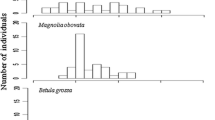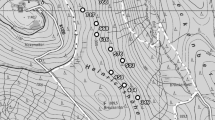Abstract
Evergreen broadleaved forests (EBLF), the zonal forest ecosystem of the subtropical zone in east China, have been degraded from recent anthropogenic disturbance. Understanding the role of past disturbances in EBLFs would be helpful to the restoration of degraded EBLFs. We used dendroecological techniques to reconstruct the disturbance history of a secondary EBLF dominated by Schima superba and Castanopsis carlesii in Tiantong National Forest Park (29°48′N, 121°47′E), Zhejiang Province, East China. The disturbances were inferred from tree-ring growth release and long-term establishment patterns obtained from 91 overstory trees. The initial growth rates of these trees were compared to trees originating in the understory to evaluate the intensity of past disturbances. The spatial distribution patterns of disturbances were portrayed with tree mapping. The results revealed that there were five disturbances, averaging one disturbance per decade over the past half century. The first disturbance event was probably most intense given that most canopy trees established at that time and displayed high initial growth rates. The timing of the second disturbance event coincided with the documented selective logging. The last three disturbances, having lower tree growth responses and a clumped spatial distribution of gap creation, were probably the result of recurring typhoons. The first two disturbances led to tree regeneration and secondary succession, represented mainly by long-lived deciduous trees in the forest. The subsequent disturbances facilitated the stand development process, creating a complex three-dimensional structure from a pre-existing single-age cohort. This study suggests that EBLFs affected by large disturbances can recover in a few decades and the frequent gap disturbances probably facilitate its process in the early successional stages.






Similar content being viewed by others
References
Abrams MD, Orwig DA, Demeo TE (1995) Dendroecological analysis of successional dynamics for a presettlement- origin white-pine-mixed-oak forest in the Southern Appalachians, USA. J Ecol 83:123–133
Baker PJ, Bunyavejchewin S (2006) Suppression, release and canopy recruitment in five tree species from a seasonal tropical forest in western Thailand. J Trop Ecol 22:521–529
Baker PJ, Bunyavejchewin S, Oliver CD, Ashton PS (2005) Disturbance history and historical stand dynamics of a seasonal tropical forest in western Thailand. Ecol Monogr 75:317–343
Bao WK, Liu ZG, Yuan YF, Liu RD, Liu CL (2001) Gap formation features of humid evergreen broad-leaved forest in central subtropical Wawushan Mountain, Sichuan Province, China. Chin J Appl Ecol 12:485–490 (in Chinese)
Brienen RJW, Zuidema PA (2006) Lifetime growth patterns and ages of Bolivian rain forest trees obtained by tree ring analysis. J Ecol 94:481–493
Canham CD (1988) Growth and canopy architecture of shade-tolerant trees: response to canopy gaps. Ecology 69:786–795
Canham CD (1989) Different responses to gaps among shade-tolerant tree species. Ecology 70:548–550
Cao KF, Ohkubo T (1999) Suppression and release during canopy recruitment in Fagus crenata and Acer mono in two old-growth beech forests in Japan. Plant Ecol 145:281–290
Chen ZH, Wang BS, Zhang HD (1998) Growth of the trees and saplings in the lower subtropical evergreen broad-leaved forest in Heishiding, Guangdong Province. Acta Phytoecol Sin 23:441–450 (in Chinese)
Cheng JC, Yang J, Liu P (1992) Anatomy and properties of Chinese woods. Chinese Forestry Publishing, Beijing (in Chinese)
Da LJ, Song K (2008) Experimental ecology research on destroyed evergreen broad-leaved forests in TNFP, Zhejiang (I): ecological restoration experiments and long-term ecological study. J East China Norm Univ (Nat Sci) 4:1–11 (in Chinese)
Da LJ, Yang YC, Song YC (2004) Population structure and regeneration types of dominant species in an evergreen broadleaved forest in Tiantong National Forest Park, Zhejiang Province, Eastern China. Acta Phytoecol Sin 28:376–384 (in Chinese)
Denslow JS, Ellison AM, Sanford RE (1998) Tree-fall gap size effects on above- and below-ground processes in a tropical wet forest. J Ecol 86:597–609
Enoki T (2003) Microtopography and distribution of canopy trees in a subtropical evergreen broad-leaved forest in the northern part of Okinawa Island, Japan. Ecol Res 18:103–113
Fujita T, Itaya A, Miura M, Manabe T, Yamamoto S (2003) Long-term canopy dynamics analysed by aerial photographs in a temperate old-growth evergreen broad-leaved forest. J Ecol 91:686–693
Grau HR, Easdale TA, Paolini L (2003) Subtropical dendroecology—dating disturbances and forest dynamics in northwestern Argentina montane ecosystems. Fort Ecol Manag 177:131–143
Huang J, Wang X, Yan E (2007) Leaf nutrient concentration, nutrient resorption and litter decomposition in an evergreen broad-leaved forest in eastern China. For Ecol Manag 239:150–158
Jiang LC, Liu LZ, Wang XH (2007) Forming Characteristics of Gap in an evergreen broad-leaved forest in Tiantong National Forest Park, Zhejiang Province, eastern China. J East China Norm Univ (Nat Sci) 6:88–96 (in Chinese)
Kira T (1991) Forest ecosystems of east and Southeast Asia in a global perspective. Ecol Res 6:185–200
Li X, He W, Dong M (1997) A preliminary study on gap dynamics of Gordonia acuminata population in Jinyun Mountain. Acta Ecol Sin 17:543–548 (in Chinese)
Lorimer CG (1980) Age structure and disturbance history of a southern Appalachian virgin forest. Ecology 61:1169–1184
Lorimer CG, Frelich LE (1989) A methodology for estimating canopy disturbance frequency and intensity in dense temperate forests. Can J For Res 19:651–663
Mabry CM, Hamburg SP, Lin TC, Horng FW, King HB, Hsia YJ (1998) Typhoon disturbance and stand-level damage patterns at a subtropical forest in Taiwan. Biotropica 30:238–250
Miura M, Yamamoto S (2003a) Effects of sprouting and canopy states on the structure and dynamics of a Castanopsis cuspidata var. sieboldii sapling population in an old-growth evergreen broad-leaved forest. For Ecol Manag 89:187–193
Miura M, Yamamoto S (2003b) Structure and dynamics of a Castanopsis cuspidata var. sieboldii population in an old-growth, evergreen, broad-leaved forest: the importance of sprout regeneration. Ecol Res 18:115–129
Miura M, Manabe T, Nishimura N, Yamamoto S (2001) Forest canopy and community dynamics in a temperate old-growth evergreen broad-leaved forest, south-western Japan: a 7-year study of a 4-ha plot. J Ecol 89:841–849
Nowacki GJ, Abrams MD (1997) Radial-growth averaging criteria for reconstruction disturbance histories from presettlement-origin oaks. Ecol Monogr 67:223–249
Payette S, Filion L, Delwaide A (1990) Disturbance regime of a cold temperate forest as deduced from tree-ring patterns: the Tantaré Ecological Reserve, Quebec. Can J For Res 20:1228–1241
Peng SJ, Huang ZL, Zhou GY, Zhou XY, Zhang C, He WQ (2003) Gap formation characteristics and its effects on sapling composition and diversity in Dinghushan Biosphere Reserve. J Trop Subtrop Bot 11:229–235 (in Chinese)
Perry GLW (2004) SpPack: spatial point pattern analysis in Excel using Visual Basic for Applications (VBA). Env Modell Softw 19:559–569
Pickett STA, White PS (1985) The ecology of natural disturbance and patch dynamics. Academic Press, New York
Song YC, Cheng XY (2007) Degradation mechanism and ecological restoration of evergreen broad-leaved forest ecosystem in east China. Science Press, Beijing (in Chinese)
Song YC, Wang XR (1995) Vegetation and flora of Tiantong National Forest Park. Zhejiang Province China. Shanghai Science and Technology Literature Press, Shanghai (in Chinese)
Song K, Yang XF, Kang MM, Da LJ (2008) Experimental ecology research on destroyed evergreen broad-leaved forests in TNFP, Zhejiang (I): the growth patterns of dominant evergreen trees determined by tree ring analysis. J East China Norm Univ (Nat Sci) 4:12–24 (in Chinese)
Sousa WP (1984) The role of disturbance in natural communities. Annu Rev Ecol Syst 15:353–391
Splechtna BE, Gratzer G, Black BA (2005) Disturbance history of a European old-growth mixed-species forest—a spatial dendro-ecological analysis. J Veg Sci 16:511–522
Wang XH, Yan ER, Yan X, Wang LY (2005) Analysis of degraded evergreen broad-leaved forest communities in Eastern China and issues in forest restoration. Acta Ecol Sin 25:1796–1803 (in Chinese)
Wang XH, Kent M, Fang XF (2007) Evergreen broad-leaved forest in Eastern China: its ecology and conservation and the importance of resprouting in forest restoration. For Ecol Manag 245:76–87
Worbes M, Staschel R, Roloff A, Junk WJ (2003) Tree ring analysis reveals age structure, dynamics and wood production of a natural forest stand in Cameroon. For Ecol Manag 256:837–843
Wu ZY (1980) Vegetation of China. Science Press, Beijing (in Chinese)
Yamamoto S (1997) Some features of the forest dynamics of warn-temperate evergreen broad-leaved forest in Japan. Nat Hist Res 4:127–131
Yan E, Wang X, Huang J (2006) Shifts in plant nutrient use strategies under secondary forest succession. Plant Soil 289:187–197
Yang TH, Da LJ, Song YC, Yang YC, Wang LY (2005) Biomass of evergreen broad-leaved forest in Tiantong National Forest Park, Zhengjiang Province (I). Community structure and fresh weight biomass of main tree species. J Zhejiang For Coll 22:363–369 (in Chinese)
Yang L, Huang XL, Wang XH, Wang LY, Jiang LC (2006) Characteristics of typhoon disturbance on evergreen broad-leaved forest at Tiantong National Forest Park. J Zhejiang For Sci Technol 26:10–14 (in Chinese)
Zhang YM, Zhou GY, Wen DZ, Zhang DQ, Zhang XM (2003) Dynamics of the Castanopsis Chinensis-Schima Superba-Cryptocarya Concinna Community Of monsoon evergreen broadleaved forest in Dinghushan Nature Reserve in lower subtropical China. Acta Phytoecol Sin 27:256–262 (in Chinese)
Zhang C, Huang ZL, Shi JH, Li L, Wei SG, Li J (2006) Dynamics and causes of woody plant death in the monsoon evergreen broad-leaved forest in Dinghushan Nature Reserve. Acta Ecol Sin 26:2457–2462 (in Chinese)
Acknowledgments
We would like to thank the anonymous reviewers and managing editor for constructive comments and suggestions. The authors are grateful to Yang Yong-Chuan, Fang He-Jun, Li Lin, Wang Liang-Yan for field assistance and Song Yao-Bin, Yang Xu-Feng for treering data collection. We acknowledge the help of Zhang Kai-Xuan for figure assistance. This study was funded by a grant from the National Natural Science Foundation of China (30721140306, 30700094, 40971041) and the “211 Project (third stage)”- supported key academic discipline program of ECNU.
Author information
Authors and Affiliations
Corresponding author
Electronic supplementary material
Below is the link to the electronic supplementary material.
Rights and permissions
About this article
Cite this article
Song, K., Yu, Q., Shang, K. et al. The spatio-temporal pattern of historical disturbances of an evergreen broadleaved forest in East China: a dendroecological analysis. Plant Ecol 212, 1313–1325 (2011). https://doi.org/10.1007/s11258-011-9907-1
Received:
Accepted:
Published:
Issue Date:
DOI: https://doi.org/10.1007/s11258-011-9907-1




